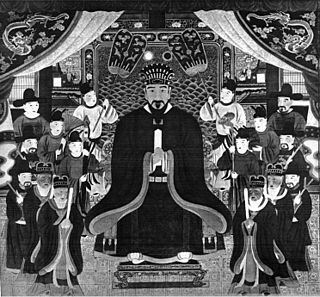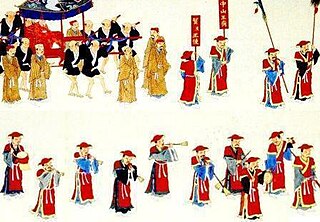Related Research Articles

The Japanese missions to Imperial China were diplomatic embassies which were intermittently sent to the Chinese imperial court. Any distinction amongst diplomatic envoys sent from the Japanese court or from any of the Japanese shogunates was lost or rendered moot when the ambassador was received in the Chinese capital.

The Ryukyu Kingdom was a kingdom in the Ryukyu Islands from 1429 to 1879. It was ruled as a tributary state of imperial Ming China by the Ryukyuan monarchy, who unified Okinawa Island to end the Sanzan period, and extended the kingdom to the Amami Islands and Sakishima Islands. The Ryukyu Kingdom played a central role in the maritime trade networks of medieval East Asia and Southeast Asia despite its small size. The Ryukyu Kingdom became a vassal state of the Satsuma Domain of Japan after the invasion of Ryukyu in 1609 but retained de jure independence until it was transformed into the Ryukyu Domain by the Empire of Japan in 1872. The Ryukyu Kingdom was formally annexed and dissolved by Japan in 1879 to form Okinawa Prefecture, and the Ryukyuan monarchy was integrated into the new Japanese nobility.
Bunei was King of Chūzan. He was the second and last ruler of the Satto dynasty.
Satto (察度) was King of Chūzan. He is the first ruler of Okinawa Island who was recorded by contemporary sources. His reign was marked by expansion and development of Chūzan's trade relations with other states, and the beginning of Okinawa's tributary relations with Ming dynasty China, a relationship that continued for roughly five hundred years, almost until the fall of the Qing dynasty.

Shō Gen was king of the Ryukyu Kingdom from 1556 to 1572. He was called "Gen, the mute." The king required considerable support from the Sanshikan, the chief council of royal advisors. His reign marked the beginning of the council's demonstration of significantly greater effectiveness and efficiency than previously.

Over the course of Japan's Edo period, the Ryūkyū Kingdom sent eighteen missions to Edo, the capital of Tokugawa Japan. The unique pattern of these diplomatic exchanges evolved from models established by the Chinese, but without denoting any predetermined relationship to China or to the Chinese world order. The Kingdom became a vassal to the Japanese feudal domain (han) of Satsuma following Satsuma's 1609 invasion of Ryūkyū, and as such were expected to pay tribute to the shogunate; the missions also served as a great source of prestige for Satsuma, the only han to claim any foreign polity, let alone a kingdom, as its vassal.
Tsūkō ichiran (通航一覧) is a mid-19th century Japanese compilation of documents or "survey of intercourse" related to the foreign relations of the Tokugawas and the Tokugawa shogunate.
The Korean Joseon dynasty (1392–1897) sent numerous diplomatic missions to the Chinese Ming (1368–1644) and Qing (1644–1912) dynasties.
Joseon diplomacy was the foreign policy of the Joseon dynasty of Korea from 1392 through 1910; and its theoretical and functional foundations were rooted in Neo-Confucian scholar-bureaucrats, institutions and philosophy.
Japanese missions to Ming China represent a lens for examining and evaluating the relationships between China and Japan in the 15th through the 17th centuries. The nature of these bilateral contacts encompassed political and ceremonial acknowledgment as well as cultural exchanges. The evolution of diplomatic ties accompanied the growing commercial ties which grew over time.
Gyorin was a neo-Confucian term developed in Joseon Korea. The term was intended to identify and characterize a diplomatic policy which establishes and maintains amicable relations with neighboring states. It was construed and understood in tandem with a corollary term, which was the sadae or "serving the great" policy towards Imperial China.
Kenchū Keimitsu (堅中圭密) was a Japanese Zen Buddhist monk and diplomat in the Muromachi period. He was the chief envoy of a mission sent by the Ashikaga shogunate to the court of the Yongle Emperor in Nanjing. He would return to China at the head of four subsequent missions to the Chinese Imperial court in Beijing.

Sakugen Shūryō was a Japanese Zen Buddhist monk, a poet and diplomat in the Muromachi period. He was the chief envoy of a 1547 mission sent by the Ashikaga shogunate to the court of the Jiajing Emperor in Beijing.
Ryōan Keigo was a Japanese Zen Buddhist monk and diplomat in the Muromachi period. He was the chief envoy of a 1511–1513 mission sent by the Ashikaga shogunate to the court of the Zhengde Emperor in Beijing.
Imperial Chinese missions to the Ryukyu Kingdom were diplomatic missions that were intermittently sent by the Yuan, Ming and Qing emperors to Shuri, Okinawa, in the Ryukyu Islands. These diplomatic contacts were within the Sinocentric system of bilateral and multinational relationships in the Sinosphere.
Ryukyuan missions to Joseon were diplomatic and trade ventures of the Ryūkyū Kingdom which were intermittently sent in the years 1392–1879. These diplomatic contacts were within the Sinocentric system of bilateral and multinational relationships in East Asia. The Ryukyuan King Satto established formal relations with the Joseon court.
Shishō, or Shō Shishō (尚思紹) in later sources, was Anji of Sashiki and later King of Chūzan, one of three polities on the island of Okinawa, before they were united. He was the progenitor of what became the First Shō dynasty.
Joseon missions to the Ryukyu Kingdom were diplomatic and trade ventures of the Joseon dynasty that were intermittently sent after 1392. These diplomatic contacts were within the Sinocentric system of bilateral and multinational relationships in East Asia. The Ryukyuan King Satto established formal relations with the Joseon court.

The Ryukyu Domain was a short-lived domain of the Empire of Japan, lasting from 1872 to 1879, before becoming the current Okinawa Prefecture and other islands at the Pacific edge of the East China Sea.

The foreign relations of the Ryukyu Kingdom were shaped through heavy mutual contact and trade with surrounding nations, most notably Japan and China. The influence exerted by both of these nations differ throughout each era of Ryukyuan history. To a lesser extent, other nations played a role in Ryukyuan diplomacy.
References
- Kang, David C. (2010). East Asia Before the West: Five Centuries of Trade and Tribute. New York : Columbia University Press. ISBN 9780231153188; OCLC 562768984
- Hendrickx, Katrien (2007), The Origins of Banana-fibre Cloth in the Ryukyus, Japan, Leuven University Press, ISBN 978-90-5867-614-6
- Kerr, George H. (1965). Okinawa, the History of an Island People. Rutland, Vermont: C.E. Tuttle Co. OCLC 39242121
